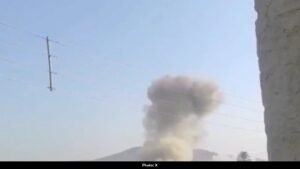A 5.6-magnitude earthquake struck Afghanistan on Friday, sending tremors across multiple regions of Jammu and Kashmir. The quake occurred at a depth of 10 km near the Afghanistan-Tajikistan border around 5:45 pm.
This incident comes just days after a devastating 6.2-magnitude earthquake hit southeastern Afghanistan on September 4, one of the deadliest in recent years, claiming over 2,200 lives.
“Latest information about the casualties of the Kunar earthquake: The bodies of hundreds of martyrs have been removed in search and rescue operations in the earthquake-affected areas of Mazar-e-Dre, Chacha Gul-dre, and Manogi district of Nurgal district of Kunar. The total number of martyrs has increased to 2205 and the number of injured has increased to 3640.” — Hamdullah Fitrat
A magnitude 5.6 earthquake just struck about 46 km southeast of Khandūd, Afghanistan.
A 5.8-magnitude earthquake just occurred 223 km north of Mingora, Pakistan. pic.twitter.com/7i2gZPteA7
— Weather Monitor (@WeatherMonitors) October 17, 2025
Afghanistan’s Vulnerability to Earthquakes
Afghanistan is located in one of the world’s most active seismic zones, where the Indian and Eurasian tectonic plates collide. This immense geological pressure causes fractures and folds in the Earth’s crust. In the Hindu Kush mountains, parts of the lithosphere are pushed deep into the mantle, triggering frequent powerful earthquakes.
Regional Impact and Tremors in India
The latest earthquake sent tremors across Jammu and Kashmir, highlighting the cross-border impact of seismic activity in northern Afghanistan. While northern regions like the Pamir-Hindu Kush often experience deep quakes, shallow quakes along the Sulaiman Range in western Pakistan and southeastern Afghanistan frequently cause severe destruction.
Authorities are monitoring the situation closely, and rescue operations continue in the affected areas.



